|
SAIC PD-10i (2008/04)
Finally I have got a working SAIC gamma radiation
dosimeter. I already bought an overpriced (dont ask), new PD-12i in July 2007 from
a certain company in Singapore, whose GM-tube failed after only 2 weeks of operation.
The failure is very strange, the tube randomly but temperature dependent gives off
many pulses without any causing radiation, resulting in displays of up to 300µSv/h
(eek!) yet remains sensitive to radiation, by giving off more pulses.
Anyway, I now got a working PD-10i used on ebay, it displays in Röntgen or REM, as opposed
to the Sievert displaying PD-12i, but this really isnt an issue. Its a very nice gadget
as it monitors radiation levels 24/7 with the use of only a single AA alkaline or rechargeable,
lasting about a month!
|
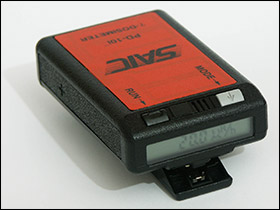
SAIC PD-10i gamma dosimeter
|
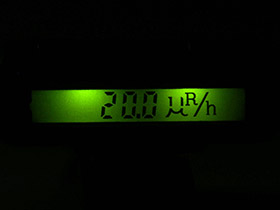
SAIC PD-10i with backlight
|
In my opinion this is the best dosimeter out there, very small and looks just like a pager.
And this is no coincidence, as the case SAIC used is taken from Motorola's Bravo pagers
that were introduced in the 80s! I think its a very timeless design and fits the dosimeter well.
It even has a beautiful pushbutton-activated backlight, as seen on the left.
|
Now lets talk a little about the technology:
It contains a small Geiger-Müller tube, surrounded by aluminum and copper foil,
energy compensated. There is a MAX856 step up regulator used to generate 5V from the AA sized cell.
This IC also has a low-battery detector, which we shall discuss in a little more detail later.
The current drawn from the battery in active mode is about 2 to 4mA. The high voltage for the
GM tube is regulated at surprisingly accurate 550V, and remains in regulation even when attaching
a 10Mohm multimeter to measure it. The dosimeter controller monitors the presence of the high voltage,
and will warn if there is a failure.
|
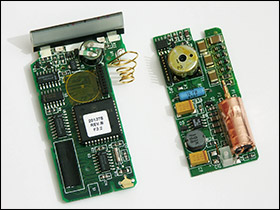
SAIC PD-10i gamma dosimeter PCBs
|
The high voltage is produced by a switching regulator, followed by a cascade circuit represented
by the 4 capacitors/diodes on the power PCB. This type of switching supply is also what I am going
to use on my Geiger-Counter project, with a similar step-up configuration, followed by a cascade,
and a feedback voltage divider in the 500Mohm to 1Gohm range for the regulation.
The measuring of dose rate is done by measuring the pulse count of the tube in a certain interval.
The intervals length is chosen depending on the intensity of the radiation, mostly being at its
maximum of 1024 seconds (17 minutes) when only background radiation is present. In this mode the
displayed dose rate will range from 0 to about 80µR/h, it never went higher in all the time i
have used it. Only of course when I subject it to some radiation other than just background.
After almost 17 days of operation (407 hours) and accumulated dose of 5.06mR, the average dose
rate is 12.4µR/h, or 298µR/day, which would accumulate to 109mR in 1 year. One GM pulse corresponds
to about 1.5µR depending on calibration, which in background gives about 8.3 pulses per hour,
or 1 pulse every 7.3 minutes. So you can see it is not very well suited for low level radiation,
but it still does its job very well, and will warn you with a loud beeper when the alarm
threshold is reached.
I have to say, currently (2008) the solar activity is rather low - the last maximum was in 2000,
and the next is in 2011, and I have only started to measure and monitor radiation in 2005, so im
really eager to see if there will be anything measurable in the years to come. And sadly I have never
flown in an airplane all my life, there would be definitely something measurable.
Since this model was discontinued by SAIC, I have a local copy of the Datasheet, as well as the
probably hard to get user manual:
SAIC PD-10i Datasheet (PDF)
SAIC Operation and Maintenance Manual (PDF)
SAIC PD-10i user manual page 1
SAIC PD-10i user manual page 2
|
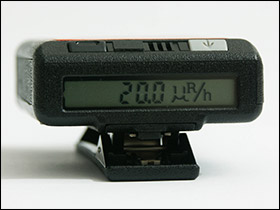
SAIC PD-10i gamma dosimeter display
|
Now back to the low-battery detection:
The original device has an advertised low-bat threshold of 1.25V, actually this is 1.27V. When the cell
voltage drops below this level, the low battery icon will appear and if the option is activated,
the dosimeter will shut down 24 hours after that. I am a person who dislikes non-rechargeable cells,
using rechargeables for each and everything. At 1.27V a rechargeable has merely given of maybe half
of its charge. So I simply figured out a way to lower this threshold to 1.15V. The MAX856 has an
internal reference of 1.25V, so on first thought you cant push the threshold any lower than that.
But on second thought, you can pull up the voltage at the low battery detection pin so that it
will have reached 1.25V when the battery is actually lower than that - by pulling it up to the
regulated 5V rail.
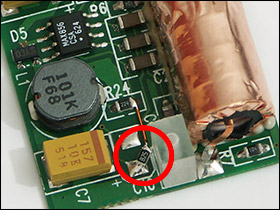
Low battery fix for rechargeables
|
In the photo on the left you can see how this is done. I added an 8meg2 SMD resistor from the nearest
5V pad to the low battery detection pin of the regulator chip. This pin is connected to the actual
cell voltage by a 220k resistor (R24), and being pulled up to 5V by 8.2MOhm there will be 1.25V at the IC,
when the battery is actually at 1.15V.
There is no problem with the low voltage, the switching regulator works down to 0.8V if you trust the
datasheet of the MAX856, but I also confirmed this by testing with a variable voltage.
|
For the sake of completeness I have to state that it actually triggers at 1.165V due to the input current of
the IC's sensing pin. Changing the 8.2Mohm to 6.8Mohm would very well compensate this, but I first
will run the battery down to see how long it takes for the symbol to appear, and then decide if I swap the
resistor. After all, it should be able to run for another 24 hours after the threshold is reached, and
ideally not discharge the battery lower than 1.0V in doing so.
Well, so much for this little article, I hope you enjoyed it.
If you have any questions or suggestions, you can always mail me.
Update - Raised the Low-Bat threshold (2008/05)
I have now run the battery down, and found out the threshold is actually set too low, the LCD backlight's
current draw in one case made the controller or switching regulator hang, since the battery voltage dropped
too fast in the end. This was close to 24 hours after the low battery indication, so raising the level a
little should suffice. I managed to get it up to 1.21V by changing R24 to 150kOhm. A 2000mAh AA rechargeable
will last about 20 days, with the dosimeter having a current consumption of about 2-5mA depending on battery
voltage.
Update - Tested with LSD-NiMH (2008/08)
I tested it with the new LSD (low self discharge) NiMH cells from Duracell (2000mAh), and it ran for 35 days,
until the low battery icon appeared. After another 24 hours it shut off, and the battery then still had a
voltage of 1.19V. Thats great, and much more runtime than with an equal capacity classic NiMH (20 days).
The current (2008/08/10 12:40) accumulated dose, recorded since 2008/05/05 01:32, is 28.0 mR.
This gives an average rate of 11.97 µR/h.
Update - Visit to the Krümmel Nuclear Power Plant (2009/04)
In March 2009 I did a 4 week internship at the Krümmel Nuclear Power Plant in northern Germany. Of course I
had my dosimeter with me all the time, but was a little disappointed to see no increased radiation outside of
the control zone. Plotters in the control room record radiation levels from several places, one of them being
at the outer fence right next to a public road, where the dose rate was no more than 0.15 µSv/h, which is
normal background around here.
However, on the 19th of March I was given the opportunity of a tour through the control zone (the plant is currently
offline for extensive maintenance), for which I got one of the plants dosimeters
(automess model 219.1, displays in µSv resolution)
and also took my PD-10i with me. I was really excited - finally my dosimeter came to use in its natural habitat!
The highest rate (advertised by a sign) I saw was inside the containment sphere, somewhere at the top of the
reactor pressure vessel, the sign said 600 µSv/h, but I did not stay in there long enough for my dosimeter
to sample the rate correctly.
Once done with my tour and exiting the control-zone, the plants dosimeter showed a dose of 8 µSv
(actually it was 0.008 mSv on the floating-point display), while mine displayed 780 µR, thats pretty close (100 µR = 1 µSv).
The background in my home averaged over several months is 290 µR/day, so on that tour (which took about 2.5 hours)
I got a dose of roughly 3 days worth of background radiation - thats not so bad.
But I also had my dosimeter checked by the local radiation protection division with a calibration source normally
used to check the automess dosimeters used by the plant, and this confirmed the perfectly good calibration
of my dosimeter.
 Images related to this article Images related to this article
SAIC PD-10i gamma dosimeter (angled view)
SAIC PD-10i gamma dosimeter (top view)
SAIC PD-10i gamma dosimeter (front view)
SAIC PD-10i circuit boards (top view)
SAIC PD-10i circuit boards (bottom view)
SAIC PD-10i circuit boards (xray)
SAIC PD-10i dose rate display with backlight
SAIC PD-10i dose display with backlight
SAIC PD-12i PCBs and case
SAIC PD-12i calibration certificate
automess model 219.1 dosimeters
|

